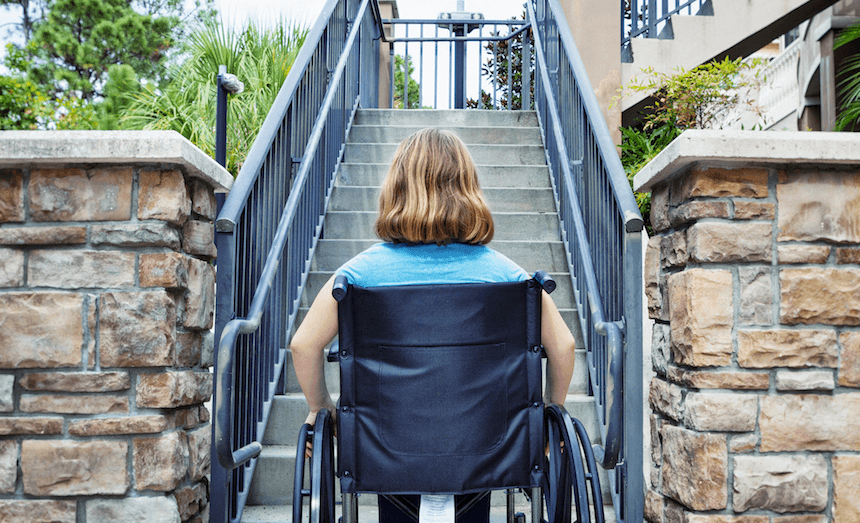A disability advocate is urging the government to make accessibility a central part of the Kiwibuild programme. Alex Braae reports.
The government’s flagship Kiwibuild policy has always intended to lead the way on housing, in the creation of good quality, affordable homes that first home buyers can spend years or even decades in. But advocates are concerned that the policy will leave the disabled community behind.
At present, design accessibility standards have not been finalised for the Kiwibuild programme. Both head of Kiwibuild Stephen Barclay and a spokesperson for minister Phil Twyford said accessibility standards were being given active consideration, with Mr Barclay adding that the goal is “to ensure KiwiBuild homes meet the needs of a diverse range of households.” But what is clear is that a significant number of the 100,000 homes build over the 10 year life of the programme will be apartments, or multi-storey buildings. And those types of buildings can present serious challenges for the disabled community, which is more sizeable than commonly assumed – about 1 in 4 New Zealanders has some form of disability or access issue.
But Geoff Penrose from CSS Disability Action says it has been a struggle to get anyone to take notice of the disabled community’s housing needs, both among governments and councils, saying “nobody wants to hear it.”
Mr Penrose wants the government to adopt the Lifemark standards across the Kiwibuild programme, which apply to both inside and outside the home. He believes three-storey walk-ups will be very attractive to Kiwibuild developers, for both aesthetic and cost reasons. But he says on a few important areas, such developments “fail to build an inclusive community.”
“The thing with the Kiwibuild programme is that the first stage is about using existing drawings that have had building consent, and now they’re going to be repurposed as Kiwibuild. So a lot of this stuff has been in existence, but what it does mean from a Kiwibuild perspective, they’re endorsing the creation of these structures that don’t lend themselves to inclusive communities.”
He said the challenges could be as simple as not having lifts in multi-storey buildings, limiting those with mobility issues to the ground floor only. Even if that’s where they live, it limits the access they can have to the rest of the building. Mr Penrose estimates the cost of including a lift in a development has traditionally been about $100,000, but that has gradually come down.
The number of people who could potentially be affected if access isn’t made a central part of the Kiwibuild programme is long. Advocates have for many years made the point that disabilities aren’t necessarily synonymous with having to use wheelchairs, for example, or other visible signs. As Kiwibuild homes are meant to be bought and lived in long term, Geoff Penrose says accessibility is an important principle to build with, because needs change over time, and New Zealand has an ageing population.
“We’ve had one client, the Salvation Army, and they looked at a three-storey dwelling in Auckland. They initially had a three-storey walkup, but then went through a review process, and we were part of that. At the end of it, they came back and said they wanted to change it, and now the plan for what is going to be built will have a lift in it. It’s not just being cheap and affordable, it’s about being usable as well,” said Mr Penrose.
And people with disabilities are much more likely to be long term renters, with all the challenges that involves. Last year disability advocate and wheelchair user Erin Gough wrote that it was a hidden housing crisis, in that it was barely ever talked about.
“Search Google news and there is article after article about people being unable to afford to buy houses, secure reasonably priced rentals, or scale Housing New Zealand’s waitlist.
What there are far fewer stories about is the crisis those who require accessible housing are facing.
But like a lot of things, just because it’s not reported as much on doesn’t mean it’s not real, and let me tell you, for me and many other New Zealanders, it is very real.”
When the recent Renters United blueprint on reforms of the rental market was released, it was strongly welcomed by the Disabled Person’s Assembly. In a release DPA spokesperson Dr Esther Woodbury said that finding housing that was both affordable and accessible was a huge challenge for the disabled community.
“It is also urgent that the government address the lack of accessible homes in our housing supply. Only two percent of New Zealand’s housing stock is currently accessible, research from universal design organisation Lifemark shows. Many young disabled people who want to leave home find they can’t; the inability to find accessible housing a huge barrier to them being able to live good lives in the community,” said Dr Woodbury.
Geoff Penrose says if the opportunity isn’t taken now to make accessibility a central part of Kiwibuild, it might not come back around for years. “The leadership in something like Kiwibuild, what you deliver and signal to the market is expected is important,” said Mr Penrose.
“In a lot of cases, if they could go back and do them again, they probably would make more homes accessible. But there hasn’t been enough long term thinking, and if the government has a responsibility for purchasing, that’s quite different from a developer testing the market. This is actually purchasing on behalf of people, and it’s not a good message at all if it’s just for some people and not for everyone.”
The Bulletin is The Spinoff’s acclaimed, free daily curated digest of all the most important stories from around New Zealand delivered directly to your inbox each morning.
